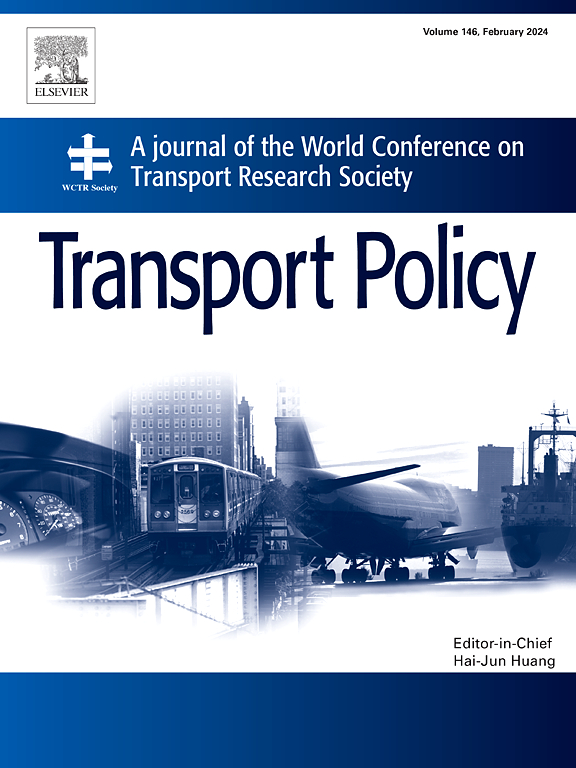The changing politics of road death in Britain: from policy action to kicking the can down the road
IF 6.3
2区 工程技术
Q1 ECONOMICS
引用次数: 0
Abstract
Britain has one of the lowest road casualty rates globally, yet tens of thousands of people are killed or seriously injured annually, and numbers have plateaued since 2012. Despite the consequential impact of road trauma, there has been limited evaluation of Britain's policy response. This paper uses Kingdon's Multiple Streams Model to understand agenda setting and analyses how road safety policies were made or not made over time. Critical discourse analysis evaluates patterns and themes in new data acquired via thirty-five interviews with politicians and policy participants, and data from Parliamentary debates and policy documents, spanning the period between 1987 and 2021. The data suggests two distinct time periods: 1987 to 2002, the policy problem was accepted, policy solutions advanced, when policy windows opened as political discourse was constructive, the multiple streams coupled, and policy change resulted. Policy development in road safety is therefore possible when it is viewed as an important policy agenda in need of attention. After 2003, there was a perception the problem had been resolved. Road safety lost out to a dominant mobility framing, road deaths were reframed as accidental and so unavoidable, solutions were contested, the politics stream flowed slowly, and from 2011, with the tight fiscal environment, discarded targets, and significant competition for attention from alternative policy areas, policy stasis resulted. The prevailing politics meant that the policy problem remained sidelined and policy solutions continued to be kicked down the road. The paper explores how this shift occurred and the consequences on the politics of road death.
英国公路死亡问题的政治变化:从政策行动到 "踢罐子
英国是全球道路伤亡率最低的国家之一,但每年仍有数万人丧生或重伤,而且自 2012 年以来,这一数字已趋于稳定。尽管道路创伤造成了严重影响,但对英国政策应对措施的评估却十分有限。本文采用 Kingdon 的 "多流模型"(Multiple Streams Model)来理解议程设置,并分析随着时间的推移,道路安全政策是如何制定或未制定的。批判性话语分析评估了新数据中的模式和主题,这些数据来自对政治家和政策参与者的 35 次访谈,以及议会辩论和政策文件中的数据,时间跨度为 1987 年至 2021 年。这些数据表明有两个不同的时间段:1987 年至 2002 年,政策问题被接受,政策解决方案得到推进,此时政策窗口打开,政治话语具有建设性,多流耦合,政策变革随之产生。因此,当道路安全被视为一个需要关注的重要政策议程时,政策制定就成为可能。2003 年之后,人们认为问题已经解决。道路安全问题失去了主导性的流动性框架,道路死亡被重新定义为意外事故,因此是不可避免的,解决方案受到争议,政治流缓慢流动,从 2011 年开始,随着财政环境的紧张、目标的废弃以及其他政策领域对注意力的激烈竞争,政策停滞不前。主流政治意味着政策问题仍被搁置一旁,政策解决方案继续被搁置。本文探讨了这种转变是如何发生的,以及对公路死亡政治的影响。
本文章由计算机程序翻译,如有差异,请以英文原文为准。
求助全文
约1分钟内获得全文
求助全文
来源期刊

Transport Policy
Multiple-
CiteScore
12.10
自引率
10.30%
发文量
282
期刊介绍:
Transport Policy is an international journal aimed at bridging the gap between theory and practice in transport. Its subject areas reflect the concerns of policymakers in government, industry, voluntary organisations and the public at large, providing independent, original and rigorous analysis to understand how policy decisions have been taken, monitor their effects, and suggest how they may be improved. The journal treats the transport sector comprehensively, and in the context of other sectors including energy, housing, industry and planning. All modes are covered: land, sea and air; road and rail; public and private; motorised and non-motorised; passenger and freight.
 求助内容:
求助内容: 应助结果提醒方式:
应助结果提醒方式:


